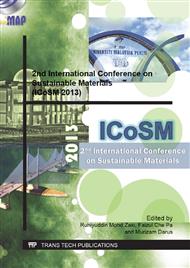p.1
p.5
p.9
p.14
p.19
p.24
p.29
p.35
p.42
Structural, Optical and Antibacterial Properties of ZnO Commercial Powder Grades
Abstract:
We investigated the structural, optoelectronic and antibacterial properties of two commercial ZnO powder namely White (rubber grade) and Pharma (pharmaceutical grade) in order to study the correlation between the structural-optical property and the antibacterial efficacy. Transmission electron microscopy (TEM) micrographs showed rod-like morphology for the Pharma specimen and grainular shape for the White sample. X-ray diffractometry (XRD) results confirmed the superior crystallinity of the Pharma powder and photoluminescence (PL) data also showed higher UV photocatalysis of the Pharma powder if compared to that of White powder. Using the broth macrodilution method to determine the antibacterial activity of ZnO specimens, we discovered the Pharma grade exhibited stronger inhibition (80-98%) on the growth of Escherichia Coli (E. coli) especially for the ZnO suspension concentration of 10-20 mM. We believe that the superior crystallinity and stronger photocatalysis of the rod-like Pharma powder could have generated much more reactive oxygen species (OH-, H2O2 and O22-) than that of White sample resulting in the higher growth inhibition of E.coli. This work also highlights the impact of rod-like primary particles of Pharma powder in exhibiting good antibacterial efficacy if compared to the grainular particles of White powder and this observation justifies the usage of ZnO Pharma powder in pharmaceutical and healthcare products.
Info:
Periodical:
Pages:
19-23
Citation:
Online since:
September 2013
Keywords:
Price:
Сopyright:
© 2013 Trans Tech Publications Ltd. All Rights Reserved
Share:
Citation:


